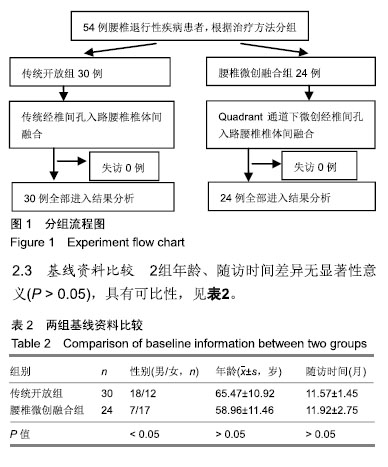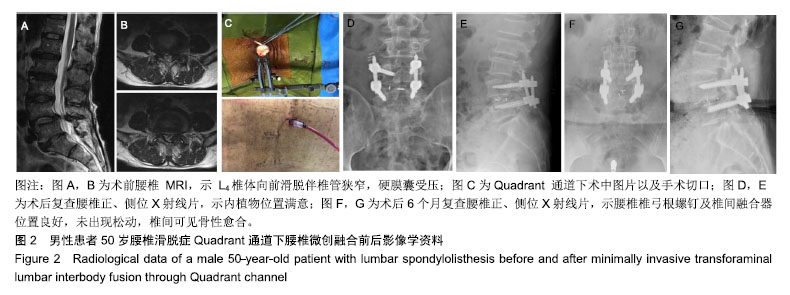| [1]Malmivaara A, Slätis P, Heliövaara M, et al. Surgical or nonoperative treatment for lumbar spinal stenosis? A randomized controlled trial.Spine (Phila Pa 1976). 2007; 32(1):1-8. [2]朱丹杰,邹成,杨迪,等.经椎间孔椎体间融合治疗单节段腰椎退行性疾病不同术式的疗效观察[J].中华医学杂志,2016,96(45): 3669-3673. [3]Lo WL, Lin CM, Yeh YS, et al. Comparing miniopen and minimally invasive transforaminal interbody fusion in single-level lumbar degeneration. Biomed Res Int. 2015; 2015:168384.[4]戈浩,吕建军. PLIF与TLIF治疗老年退变性腰椎滑脱合并腰椎管狭窄症的疗效比较[J].湖南师范大学学报(医学版),2016,13(6): 47-50.[5]范顺武,胡志军,方向前,等.腰椎后路手术中脊旁肌保护的相关思考[J].中华骨科杂志,2011,31(4):400-407.[6]Luo Z, Rao H, Huang D, et al. Comparison of minimally invasive using a tubular retraction system versus open transforaminal lumbar interbody fusion for the treatment of lumbar degenerative diseases. Zhonghua Yi Xue Za Zhi. 2015;95(33):2681.[7]Tian Y, Liu X. Clinical outcomes of two minimally invasive transforaminal lumbar interbody fusion (TLIF) for lumbar degenerative diseases. Eur J Orthop Surg Traumatol.2016; 26(7):1-7.[8]Guan J, Bisson EF, Dailey AT, et al. Comparison of clinical outcomes in the national neurosurgery quality and outcomes database for open versus minimally invasive transforaminal lumbar interbody fusion. Spine. 2015;41(7):E416.[9]Foley KT, Lefkowitz MA. Advances in minimally invasive spine surgery. Clin Neurosurg. 2002;49:499.[10]Xia XL , Wang HL , Lyu FZ ,et al. Mast Quadrant-assisted minimally invasive modified transforaminal lumbar interbody fusion: single incision versus double incision. Chin Med J (Engl).2015;128(7):871-876.[11]Mobbs RJ, Sivabalan P, Li J. Minimally invasive surgery compared to open spinal fusion for the treatment of degenerative lumbar spine pathologies. J Clin Neurosci. 2012;19(6):829-835.[12]陈志刚,吕书军,李立东,等.Quadrant通道下经肌间隙入路TLIF治疗单节段腰椎退行性疾病[J].实用骨科杂志,2016,22(2): 155-158.[13]Fairbank JC, Pynsent PB. The Oswestry Disability Index. Spine. 2000;25(22):2940.[14]朱文辉,陈岩岩.微创Wiltse入路与传统后正中入路手术在双节段腰椎管狭窄症中的应用比较[J].中国现代医药杂志,2016, 18(6):24-27.[15]Teng I, Han J, Phan K,et al. A meta-analysis comparing ALIF, PLIF, TLIF and LLIF. J Clin Neurosci. 2017;44:11-17.[16]Gu G, Zhang H, Fan G, et al. Comparison of minimally invasive versus open transforaminal lumbar interbody fusion in two-level degenerative lumbar disease. Int Orthop. 2014; 38(4):817-824..[17]Chusheng S, Siddiqui MA, Wong KPL,et al. Five-year outcomes of minimally invasive versus open transforaminal lumbar interbody fusion: a matched-pair comparison study. Spine. 2013;38(23):2049-2055.[18]杨佳宁,宋有鑫,赵丽丽,等.后路Quadrant通道下MIS-TLIF微创手术治疗老年退变性腰椎管狭窄症的临床疗效[J].中国矫形外科杂志,2016,24(5):395-400.[19]陈文恒,郭团茂,刘强,等.MIS-TLIF联合单侧或双侧椎弓根钉内固定治疗腰椎退行性疾病的疗效比较[J].中国骨与关节损伤杂志,2017,32(5):471-474.[20]杜怡斌,张之栋,刘艺明,等.MIS-TLIF与TLIF治疗双节段腰椎管狭窄症的疗效比较[J].临床骨科杂志,2017, 20(3):289-292.[21]陈宇,陈耀祖,周雪芬,等.经可扩张通道管手术系统微创治疗下腰椎疾患[J].中国现代手术学杂志,2010, 14(5):363-366.[22]Ozgur BM, Kevin Y, Gerardo R,et al. Minimally-invasive technique for transforaminal lumbar interbody fusion (TLIF). Eur Spine J. 2005;14(9):887.[23]Lee W, Park JY, Kim KH,et al. Minimally invasive transforaminal lumbar interbody fusion in multilevel: comparison with conventional transforaminal interbody fusion. World Neurosurg. 2016;85:236-243.[24]朱辉,原超,张文财,等. MIS-TLIF与TLIF治疗单节段腰椎退行性疾病疗效比较[J].实用骨科杂志,2017,23(6):547-550.[25]彭昊,张雷,廉凯,等.Quadrant通道下经椎间孔椎体融合术与开放后路椎体融合术治疗腰椎滑脱症的近期疗效分析[J].临床外科杂志,2017,25(8):590-593.[26]Phan K, Rao PJ, Kam AC, et al. Minimally invasive versus open transforaminal lumbar interbody fusion for treatment of degenerative lumbar disease: systematic review and meta-analysis. Eur Spine J. 2015; 24(5):1017-1030.[27]Parker SL, Mendenhall SK, Shau DN, et al. Minimally invasive versus open transforaminal lumbar interbody fusion for degenerative spondylolisthesis: comparative effectiveness and cost-utility analysis. World Neurosurg. 2014;82(1-2):230-238.[28]何祥乐,李传将,王小勇,等.Quadrant通道下MIS-TLIF治疗腰椎退行性疾病的疗效分析[J].中国骨与关节损伤杂志,2018,33(1): 24-27.[29]Epstein NE. More nerve root injuries occur with minimally invasive lumbar surgery: Let's tell someone. Surg Neurol Int. 2016;7(Suppl 3):S96-S101.[30]Villavicencio AT, Burneikiene S, Roeca CM, et al. Minimally invasive versus open transforaminal lumbar interbody fusion. Surg Neurol Int. 2010;1(1):12.[31]张威,杨克新,朱立国,等. Quadrant通道下MIS-TLIF与开放PLIF治疗腰椎退变性疾病的比较[J].中国矫形外科杂志, 2018,26(19): 1770-1774.[32]Nandyala SV, Fineberg SJ, Pelton M,et al. Minimally invasive transforaminal lumbar interbody fusion: one surgeon's learning curve. Spine J. 2014;14(8):1460-1465.[33]张永峰,张世磊,袁斌,等.显微镜辅助下经椎间孔椎间融合微创治疗腰椎退变性疾病的临床疗效比较[J].中华解剖与临床杂志, 2018,23(3):198-202. |





